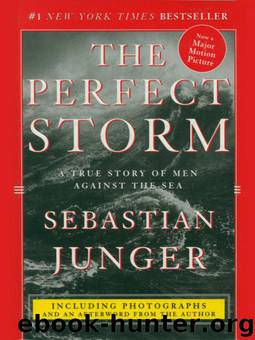Perfect Storm by Sebastian Junger

Author:Sebastian Junger [Junger, Sebastian]
Language: eng
Format: epub
Tags: Autobiography, Social Science, Movie Novels, Storms, Natural Disasters, Swordfish Fishing, Customs & Traditions, Transportation, Northeast Storms - New England, Nature, Motion Picture Plays, New England, Specific Groups, Gloucester (Mass.), Northeast Storms, Fisheries, Ecosystems & Habitats - Oceans & Seas, Tropical Storm Grace; 1997, Specific Groups - General, Ecosystems & Habitats, Alex Award, Science, Earth Sciences, Oceans & Seas, Hurricane Grace, Ships & Shipbuilding, Historical, Hurricane Grace; 1991, 1991, Ecology, 1997, Meteorology & Climatology, Tropical Storm Grace, Halloween Nor'easter, Halloween Nor'easter; 1991, General, Weather, Biography & Autobiography, Biography
ISBN: 9780060977474
Publisher: HarperCollins
THE ZERO-MOMENT POINT
Behold a pale horse, and his name who sat
on him was Death, and Hell followed with him.
—REVELATION 6:8
IN the 1950s and 1960s, the U.S. Government decided to detonate a series of nuclear devices in the Pacific Ocean. The thinking was that deep water would absorb the shock wave and minimize the effect on the environment, while still allowing scientists to gauge the strength of the explosions. But an oceanographer named William Van Dorn, associated with the Scripps Institute in La Jolla, California, warned them that a nuclear explosion in the wrong place "could convert the entire continental shelf into a surf zone."
Concerned, the Navy ran a series of wave tank tests to see what kind of stresses their fleet could take. (They'd already lost three destroyers to a typhoon in 1944. Before going down the ships had radioed that they were rolling through arcs of 140 degrees. They downflooded through their stacks and sank.) The Navy subjected model destroyers and aircraft carriers to various kinds of waves and found that a single nonbreaking wave—no matter how big it was—was incapable of sinking a ship. A single breaking wave, though, would flip a ship end over end if it was higher than the ship was long. Typically, the ship would climb the wave at an angle of forty-five degrees, fail to gain the top, and then slide back down the face. Her stern would bury itself into the trough, and the crest of the wave would catch her bow and flip her over. This is called pitch-poling; Ernie Hazard was pitch-poled on Georges Bank. It's one of the few motions that can end ship-to-shore communication instantly.
Another is a succession of waves that simply drives the boat under—"founders," as mariners say. The dictionary defines founder as "to cave in, sink, fail utterly, collapse." On a steel boat the windows implode, the hatches fail, and the boat starts to downflood. The crew is prevented from escaping by the sheer force of the water pouring into the cabin— it's like walking into the blast of a firehose. In that sense, pitch-poling is better than foundering because an overturned boat traps air in the hold and can stay afloat for an hour or more. That might allow members of the crew to swim out a doorway and climb into a life raft. The rafts are designed to inflate automatically and release from the boat when she goes down. In theory the EPIRB floats free as well, and begins signalling to shore. All the crew has to do is stay alive.
By the late hours of October 28th the sea state is easily high enough to either pitch-pole the Andrea Gail or drive her under. And if she loses power—a clogged fuel filter, a fouled prop—she could slew to the side and roll. The same rule applies to capsizing as to pitch-poling: the wave must be higher than the boat is wide. The Andrea Gail is twenty feet across her beam. But even if the
Download
This site does not store any files on its server. We only index and link to content provided by other sites. Please contact the content providers to delete copyright contents if any and email us, we'll remove relevant links or contents immediately.
Man-made Catastrophes and Risk Information Concealment by Dmitry Chernov & Didier Sornette(5647)
The Revenge of Geography: What the Map Tells Us About Coming Conflicts and the Battle Against Fate by Kaplan Robert D(3961)
Zero Waste Home by Bea Johnson(3655)
In a Sunburned Country by Bill Bryson(3365)
COSMOS by Carl Sagan(3346)
Good by S. Walden(3345)
The Fate of Rome: Climate, Disease, and the End of an Empire (The Princeton History of the Ancient World) by Kyle Harper(2870)
Camino Island by John Grisham(2719)
A Wilder Time by William E. Glassley(2689)
Organic Mushroom Farming and Mycoremediation by Tradd Cotter(2565)
The Ogre by Doug Scott(2501)
Human Dynamics Research in Smart and Connected Communities by Shih-Lung Shaw & Daniel Sui(2431)
Energy Myths and Realities by Vaclav Smil(2380)
The Traveler's Gift by Andy Andrews(2299)
9781803241661-PYTHON FOR ARCGIS PRO by Unknown(2268)
Inside the Middle East by Avi Melamed(2230)
Birds of New Guinea by Pratt Thane K.; Beehler Bruce M.; Anderton John C(2175)
A History of Warfare by John Keegan(2104)
Ultimate Navigation Manual by Lyle Brotherton(2048)
